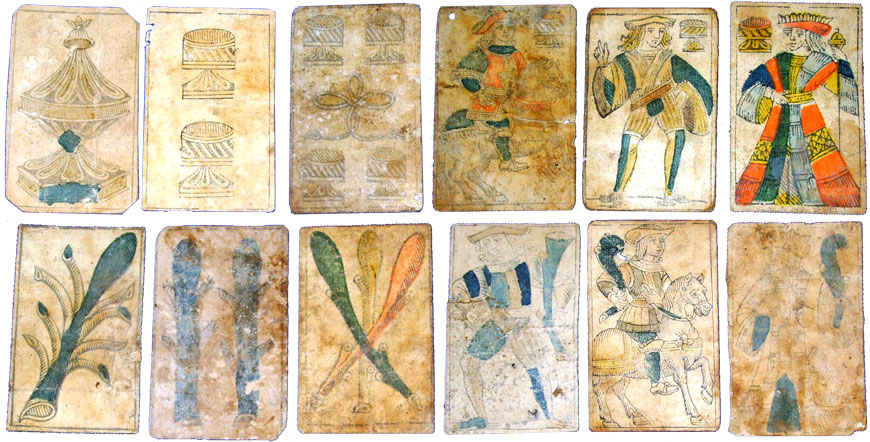Pedro Bosio
Cards of the Spanish National Pattern 'Money Bag' type manufactured by Pedro Bosio, Genova (Italy) probably during the 18th century and for export to Spain or South America.

Pedro Bosio, Genova
Spanish National Pattern / “Money Bag” Type
Italian cardmakers enjoyed lucrative trade manufacturing Spanish-suited cards for the Spanish-speaking world including South America. The variant of the Spanish National pattern shown here, known as the Money Bag pattern, is so-named bacause the Sota of Coins carries a money bag in his right hand. Whilst retaining most of the characteristics of earlier designs, it has several idiosyncrasies which differentiate it. The Ace of Coins has a central disc enclosing an eagle with the arms of Spain, with baroque cartouches above and below which read “Pedro Bosio Estanquero In Ghenova”. As in earlier models, the Five of Coins features the facing profiles of Ferdinand and Isabella, and the Four of Coins has a six-pointed star which contains the initials P.B. This derivative of the Spanish National pattern seems to have had a history outside of Spain itself and this example, originally produced in Italy, has come to light in a Chilean collection.



Above: cards manufactured by Pedro Bosio, Genova (Italy) during the 18th century and probably for export to Spain, the Philippines or South America. The Ace of Coins has the arms of Spain. The design corresponds closely to the Spanish National pattern, and specifically to the variant known as the ‘Money Bag’ type owing to the Jack of Coins holding a money bag (top row). The cavalier of cups lacks the usual inscription of ‘Ahí Va’. The cards are printed from woodblocks and hand-coloured using stencils. The backs are decorated with a pattern of ermine spots in black.
Pack made in Italy for the Spanish market
The ace of coins has the arms of Spain with cartouches with "Po Bosio. Sstanovero in Gnenov". The 2 of coins has "Naipes Finos" and on the 4 a double triangle with the initials P.B.


Above: cards by Pedro Bosio, Genoa, from 48-card pack, hand-coloured woodcut, backs printed in black with a pattern of ermine spots, 18th Century. Card size = 58x88 mm. © The Trustees of the British Museum number 1896,0501.821►
Reference: see ‘Spanish 22’ in: O’Donoghue, Freeman M: Catalogue of the collection of playing cards bequeathed by Lady Charlotte Schreiber, Trustees of the British Museum, London, 1901 [digital version here]
See another example by Pedro Bosio. See also: Giuseppe Cattino ‘Money Bag’ type by Agostino Bergallo and Hermanos Solesio.

By Simon Wintle
Member since February 01, 1996
I am the founder of The World of Playing Cards (est. 1996), a website dedicated to the history, artistry and cultural significance of playing cards and tarot. Over the years I have researched various areas of the subject, acquired and traded collections and contributed as a committee member of the IPCS and graphics editor of The Playing-Card journal. Having lived in Chile, England, Wales, and now Spain, these experiences have shaped my work and passion for playing cards. Amongst my achievements is producing a limited-edition replica of a 17th-century English pack using woodblocks and stencils—a labour of love. Today, the World of Playing Cards is a global collaborative project, with my son Adam serving as the technical driving force behind its development. His innovative efforts have helped shape the site into the thriving hub it is today. You are warmly invited to become a contributor and share your enthusiasm.
Related Articles

Late flowering of the Lyon pattern
Faustino Solesio’s late version of the Lyon pattern from about 1870.

Czech National Patterns by S.D. Modiano
Modiano produced cards with the Prague and Trappola patterns in the early 20th century.

Emilio Tadini playing cards
Beautiful dreamlike playing card designs by Emilio Tadini.

French Revolutionary cards by Pinaut
Seven cards from a French Revolutionary pack by Pinaut featuring characters from classical antiquity...

Austrian Tarock by S.D. Modiano
Modiano’s Austrian Tarock with country scenes has been in production for over 100 years.

Le carte da gioco Arcimboldo
Courts and suit-signs inspired by the works of the Italian Renaissance painter, Giuseppe Arcimboldo....

Visite Mexico
Promoting Mexican tourism with 54 different photographs in full colour.

22 Pittori in 22 Arcani
Collaborative Tarot with contributions from 22 different Italian artists including Menegazzi and Tav...

Justice playing cards
Ethical concepts in a deck produced by Riccardo Conturbia’s Passione Playing Cards Ltd.

Alan Tarot Deck
Reprint of a Tarock pack originally designed by Argio Orell for the Austrian Lloyd shipping company....

Il Tarocco del Mondo Nuovo
Imaginative Tarot card designs by Amerigo Folchi relating to Columbus and the New World.

22 Artisti Liguri in 22 Arcani
Collaborative set of major arcana devoted to Christopher Columbus and his voyages of discovery.

Carte di Colombo
Fully illustrated pack designed by Pier Canosa commemorating the 500th anniversary of the discovery ...

Carte di Natale
Designed by Pier Canosa as a Christmas pack for the Cortina Art Gallery in Milan.

Braulio Fournier
Baraja Nº 1 produced by Braulio Fournier, Burgos, c.1868.

Spanish pattern by Eugène Boisse
Spanish pattern published by Eugène Boisse, Bordeaux.
Most Popular
Our top articles from the past 28 days

